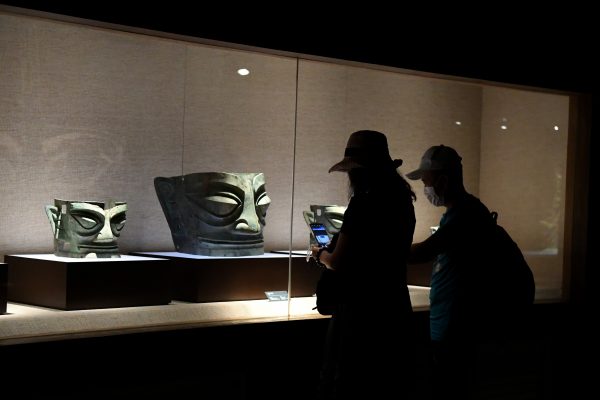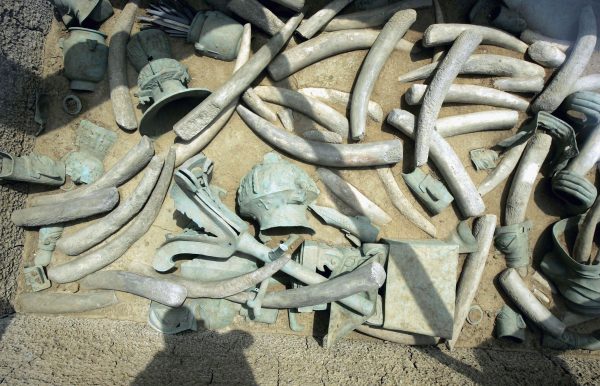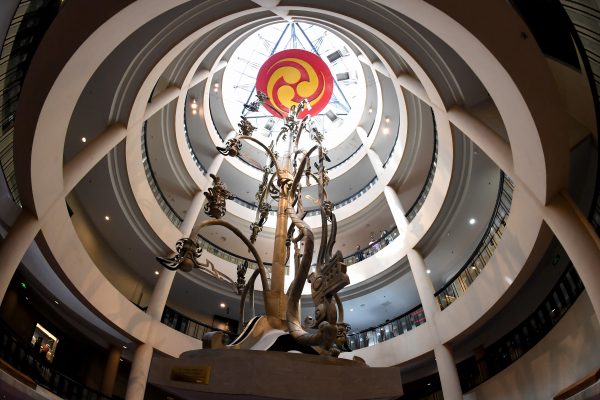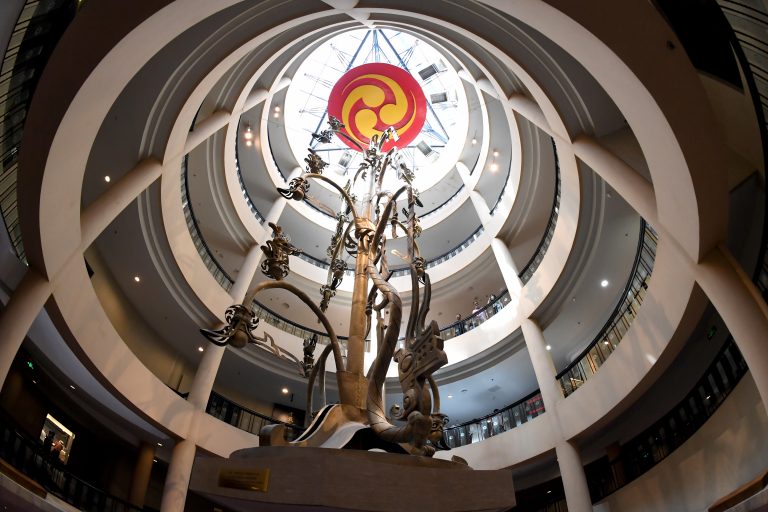On April 19, Chinese Premier Li Keqiang personally visited the archeological site of Sanxingdui in Sichuan Province, southwest China, where he told the site staff to “excavate, preserve, and investigate thoroughly.”
Sanxingdui ( 三星堆), located on the south bank of the Mianjiang River in Guanghan city, is a Bronze Age site named for three mounds of yellow earth. Though the site was discovered in the early 20th century, most work by Chinese archeologists was undertaken after 1986, when the first significant expedition discovered two ceremonial burial sites. Another major dig undertaken this March has unearthed thousands of artifacts more.
The newly discovered items include a ritual bronze tree, bronze human figures, gold mask fragments, and ivory. The civilization they appear to come from does not correspond to the known cultural heritage of the region, and the site is not described in traditional historical records.
The artifacts excavated at Sanxingdui differ strikingly from figures found in other parts of China. One famous mask, dubbed “Human face with protruding eyes,” features cylindrical “eyes” protruding from the sockets; the ears flair out like wings.

Another depiction of a human was dated as being more than 3,000 years old. The 2.62-meter-tall bronze statue (about 8 feet 7 inches) consists of a pedestal and a 1.7-meter-tall figure, dubbed the “power man.” Like the other artifact, the barefoot figure has exaggerated features, and is one of the tallest and oldest bronze statues yet discovered.
Success
You are now signed up for our newsletter
Success
Check your email to complete sign up
Lei Yu, director of the Sanxingdui Archaeological Station, contrasted the bronze artifacts founded at the site with those found in other parts of China. “Human beings being the main subject of bronzes is not a tradition of the Central China bronze culture, but a strong specialty of Sanxingdui,” he said.
In addition to being out of place with other ancient Chinese archeological digs, items discovered at the Sanxingdui site differ from the rest of the relics found in the cultural lineage of Shu (蜀), the ancient term of the Sichuan area.
Mysterious metallurgy
More intriguing, the artifacts found at Sanxingdui display advanced metallurgical technique.
For example, bronze contains zinc, and gold has a melting point of 1,064 degrees Celsius, a degree of heat previously thought impossible to produce with the productivity level found in the Shu region at the time; Third, how they came to be is puzzling as there are no large-scale mines of copper and gold nearby, not to mention processing sites and equipment.
The Sanxingdui archeological site was first discovered in 1929, when a local Daoist practitioner and his son were digging a ditch next to their house for water. They accidentally unearthed more than 300 pieces of jade and stone artifacts.
The British missionary Dong Duyi immediately called upon the local military garrison to protect the site. In 1934, he and Ge Weihan, then-director of the West China University Museum, formed an archaeological team, which unearthed more than 600 artifacts. However, the academic community at the time did not fully appreciate the historical value of the site.

In July 1986, two rural workers working at a nearby brick factory discovered some jade artifacts, which became the famous Pit No. 1, with 567 pieces of various artifacts unearthed. In August, another two rural workers discovered the second pit. This time they found bronze masks among a total of 6,095 artifacts.
The most famous ones are prominent bronze standing figures, bronze trees, a bronze face with protruding eyes, bronze divine statues, gold masks, gold scepters, as well as a large quantity of jade and ivory. Many of them are artifacts of completely unknown origin. Some artifacts are surprising, such as marine shells, because the site is far from oceans. For a while, the artifacts unearthed at Sanxingdui became a sensation in China and internationally.
‘Mountains and seas‘
There have been various theories concerning the “Ancient Shu civilization.” One popular explanation takes inspiration from the ancient Shanhaijing (山海經), or the Classic of Mountains and Seas.
The Shanhaijing dates from the pre-imperial period around 2,300 years ago, and contains many exotic and cryptic accounts of legendary monsters and strange beasts. The text’s outlandish descriptions have placed it firmly in the category of mythology.
However, some point to similarities between the artifacts discovered at Sanxingdui and the depictions found in the Shanhaijing.
For example, the Shanhaijing records a sacred tree occupied by nine golden birds, representing the sun. This corresponds to the bronze tree unearthed at the Sanxingdui site. The bronze tree is 3.96 meters high, divided into three layers, with three branches on each layer, making a total of nine branches. Each branch has a bird perched upon it.

At the same time, several bronze figures with human heads and snakelike bodies unearthed at Sanxingdui also correspond to the descriptions in the Shanhaijing. This has led some to muse that the stories in the “Shanhaijing” might not be mere legends or myths, but real historical accounts.
As more than a few Chinese commented, “Myths and legends are probably actual historical accounts, only that real history slowly turns them into mythology over time.”














